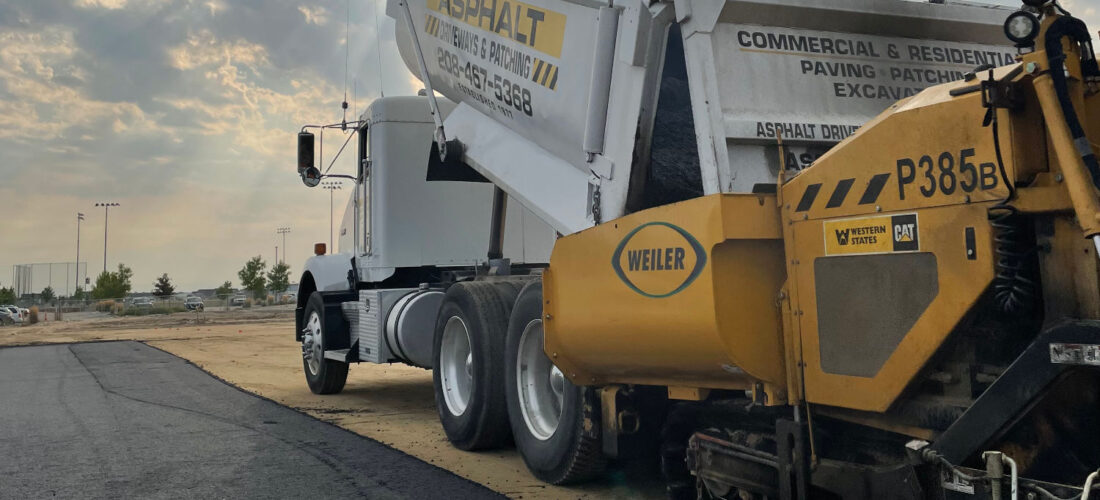
There’s more to just a blacktop and asphalt surface beyond the looks. The untrained eye can
see the bulges and imperfections, but what are the things that make a good asphalt job
excellent? Let’s look at three (3) main features of an excellent asphalt job.
1. Base Material Prepped
The material that makes up the base is crucial to the entire project. Just think of trying to lay sod over a baseball in a new backyard. It’s the same thing for what the base material below the asphalt will do if the under-material is not properly addressed. If you lay asphalt over imperfections and large debris, it will be visible from the top and will create structural integrity concerns for the asphalt on top. For reference, the layers of an asphalt project are:
- Subgrade
- Base layer(s)
- Asphalt
Good asphalt companies take the time to remove the foreign objects and non-desired substances like organic material, clay and topsoil so both the base material and the asphalt lay flat and as things settle as well as little to no imperfections are seen on the top. This makes an acceptable subgrade to start from. If the subgrade is smooth with compacted soil, it will be the best foundation to start an asphalt project. Your asphalt contractor should be familiar with the different soils in your area and make recommendations if any other modifications are needed for the subgrade.
Before a single pebble or tar can be laid, the base material underneath must be near perfect. Crushed, granular based gravel laid on a compacted subgrade has been the longtime and reliable material laid by asphalt contractors for many years. The reason why this material has been around for so long is not only because it is affordable to use on a large scale, but it allows for water to drain through it due to its coarse texture. There are all kinds of options ranging from crushed gravel like limestone C-5 and granite C-5 up to a material known as Con-Bit. It is usually desirable because it is essentially recycled concrete and individual pieces have jagged edges and allow for locking to adjacent gravel bits like a complementary puzzle piece. Using a base material that’s too fine will prevent the drainage of water underneath, and not allow for ice to form that will eventually lead to cracks, potholes and undesirable eyesores of a laid asphalt surface.
2. Base Material Compacted and Graded Correctly
After getting the best materials ready for any asphalt job, the method of how it is laid is just as important.
A good rule of thumb is to lay a total approximately 4 to 8 inches of base material to allow for extra capacity for water drainage. The first layer should not be more than 3 to 4 inches thick and then subsequent compacted layers can be laid gradually. Laying the base material in layers is best. This ensures material bonds to each other for the compacting and helps reduce large variations in the surface above. Your asphalt contractor should be familiar with how much material is needed for your area.
Skidsteer and heavy rollers then do the work leveling the base material to have a flat surface to be ready for the asphalt material. Each company has their own methods. Asphalt Driveways and Patching uses advanced grading technologies in their surface laying methods. For more information on these methods, contact us.
3. Using the Right Equipment for the Job
Speaking of equipment, let’s talk about that! It depends on the size and scope of the job. Sometimes a small skidsteer is just enough to roll over a small area or a fleet of equipment is needed to handle a road or large parking lot.
Here are a few pieces of machinery that are crucial to high quality asphalt jobs:
- Milling Machines
- Sweepers
- Dump Trucks
- Asphalt Pavers
- Compactors/Rollers
Milling machines are designed to remove top layer off of existing pavement layers to allow for an acceptable surface to lay new asphalt or repair a zone. Milling produces a grooved and rough texture on the asphalt to then allow for new material to bond onto it.
Sweepers do the detail work to remove all the excess debris after a surface has been milled. It is also considered a crucial machine because nothing is worse than a stray rock or pebble that can be freed easily from an asphalt surface and can shoot out and damage a car windshield or even a person! Just as you would sweep up your wood subfloor before you lay a new surface in your home, the same is true for pavement.
Dump trucks keep the workers and nearby pedestrians safe by transporting the hot asphalt between zones of the asphalt job. They can use a conveyor system to sling the material accurately in tight spaces or can be safely piled in work zones for the rollers and skidsteers to lay.
Asphalt pavers are the self-propelled laydown machine that take the hot mix asphalt material and level it as it is laid. The most important part of this device is the screed because it determines the thickness of the material being laid. Keeping this device serviced and in working order is crucial to the overall asphalt job.
Compactors/Rollers can take on many sizes, but they are variations of the paver screed, the steel wheeled roller and the pneumatic tire roller. Each piece has a different function in the final stages of the asphalt process.
Contact us to learn more about asphalt base materials and our best practices for driveway
installations.